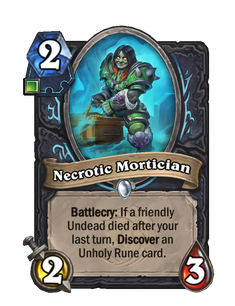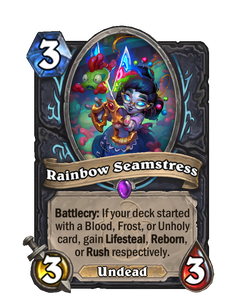Rune
Runes are a special feature found only on death knight cards and deck-building.
There are three types of Runes: Blood, Frost, and Unholy. For lists of cards in specific rune types, see their respective pages.
Functionality[edit | edit source]
- While creating a deck, death knights must choose any combination of the three runes: Blood, Frost, and Unholy. That choice of runes will then determine what cards they can put in their deck.
- Some death knight cards have a rune indicator on their card, under the mana cost.
- These cards can only be put in a deck if the amount of runes while building a deck is at least the amount indicated on the card.
- Example:
 Battlefield Necromancer, a card with 2 Unholy runes, can be put in a deck built with 2 or 3 Unholy runes, but not a deck with only 1 or 0 Unholy runes.
Battlefield Necromancer, a card with 2 Unholy runes, can be put in a deck built with 2 or 3 Unholy runes, but not a deck with only 1 or 0 Unholy runes. - Example:
 Fistful of Corpses, a card with 1 Blood and 1 Unholy rune, can only be put in a deck that has at least 1 Blood and 1 Unholy rune. Only having 1 Blood but no Unholy runes is not enough; both types must be present.
Fistful of Corpses, a card with 1 Blood and 1 Unholy rune, can only be put in a deck that has at least 1 Blood and 1 Unholy rune. Only having 1 Blood but no Unholy runes is not enough; both types must be present. - Example:
 Climactic Necrotic Explosion, a card with one of each rune, can only be put into a deck with one of each rune. It does not mean it can be included in a deck with any combination of runes.
Climactic Necrotic Explosion, a card with one of each rune, can only be put into a deck with one of each rune. It does not mean it can be included in a deck with any combination of runes. - The general takeaway from these examples is that your deck's runes must include all types indicated on the card, not just one of them.
- The runes on cards are shaped and color-coded. Blood runes are red diamonds, Frost runes are blue circles, and Unholy runes are green squares.
- Some death knight cards do not require any runes to be put in a deck. These cards do not have a rune indicator under their mana cost.
Notes[edit | edit source]
- After Patch 26.0.4.173781, cards with triple-rune requirements (e.g.
 Frostwyrm's Fury with Frost-Frost-Frost, or
Frostwyrm's Fury with Frost-Frost-Frost, or  Climactic Necrotic Explosion with Blood-Frost-Unholy) cannot be randomly generated or Discovered. For more information and examples of how exclusions in card generation function, see Game Mechanics Updates.
Climactic Necrotic Explosion with Blood-Frost-Unholy) cannot be randomly generated or Discovered. For more information and examples of how exclusions in card generation function, see Game Mechanics Updates.
- Prior to patch 26.0.4, the player's choice of runes did not affect what cards they could generate during the course of a game.[1]
- There are a total of 10 possible rune combinations a death knight can use to build their deck:
- 1 Blood, 1 Frost, 1 Unholy
- 2 Blood, 1 Frost
- 2 Blood, 1 Unholy
- 2 Frost, 1 Blood
- 2 Frost, 1 Unholy
- 2 Unholy, 1 Frost
- 2 Unholy, 1 Blood
- 3 Blood
- 3 Frost
- 3 Unholy
Tips[edit | edit source]
Gameplay[edit | edit source]
Generally speaking, the deeper you go into a particular Rune, the more you can tap into the types of things that Runes specializes in. Some of Death Knight’s most powerful cards require you to fully commit to one Rune, but sometimes tapping into a secondary Rune is a great way to cover your primary Rune’s weaknesses. For instance, the Blood Rune tends to play a few big minions and not many small ones, so you need to decide whether you want to run the very powerful triple Blood cards or if you’d rather add a single Unholy Rune for some Corpse generators.[2]
Deckbuilding[edit | edit source]
- In deckbuilding, your Rune selections will automatically update as you add cards to your deck.[2]
- You can choose to either "Show All Runes" or uncheck that option and the deckbuilder will dynamically filter as you add cards to your deck, automatically hiding cards that are incompatible with your Rune selections.[2]
- You can also filter your collection by a particular Rune by searching for “runes:---” where the “-”s are replaced by “b” “f” or “u”. For example, the search “runes:bb” would return all your double-Blood cards, and the search “runes:u” would return all your single-Unholy cards.[2]
- Alternatively, you can search by the Rune as a number. For example, the search “Unholy:1” would return all your single Unholy cards. You can also add a range. For example, the search “Frost:1-2" would return all your single and double Frost cards.[2]
- Frost is a special case because it is a Rune and a spell school. To differentiate, you can search for “school:frost” to return all Frost spell school cards without also getting all the Frost Rune cards. You can also search “school:none” to find spells that don’t have any Spell School.[2]
Cards[edit | edit source]
For lists of cards in different Rune types, see the following pages:
- Main article: Blood (Rune)
- Main article: Frost (Rune)
- Main article: Unholy (Rune)
- Main article: Rune/List of no-rune cards
- Main article: Rune/List of multi-rune cards
Related cards[edit | edit source]
- For Wild format listings, see Rune/Wild format.
These cards have effects related to Runes.
History[edit | edit source]
Development[edit | edit source]

During the early development of death knight, the rune system went through major revisions. One concept was making use of passive abilities. Blood decks had Blood Presence, Frost decks had Frost Presence, and Unholy decks had Unholy Presence.
Early experiments included using runes as a resource, much like World of Warcraft. Death Knights would not have mana, but would use runes instead, or alternatively both mana and runes. Cards during this phase had a mana cost and a rune cost. Every other turn, the player would gain a rune of their choice based on their deck. This concept "sounded cool in theory", but developers decided mana was already enough to control what cards can be played in a turn. However, developers liked the deck-building aspect of runes that spawned off this concept, which is where the current 3-rune deck-building system got its start.
Developers liked the new rune system because it allowed death knights to have powerful tools in a more controllable way. The rune system allows death knights to have a wide variety of mechanics, but not all of them. Players have to pick and choose which they want to use.
Frost cards originally had the majority of area of effect spells, until they were primarily moved to Blood cards. Likewise, Blood cards had the best card draw, but that shifted to Frost cards.
The idea of the three rune system is that the deeper one goes into a specific rune, the more of that rune's core fantasy they get. With Blood cards, single-rune cards may have single-target Lifesteal spells, to AOE Lifesteal spells on double-rune cards, and finally max health manipulation on triple-rune cards.
Triple-rune cards are designed to be more powerful than ones with just one, two, or no runes, because the player is sacrificing many options when getting to use those cards. However, triple-rune cards are not necessarily designed to be the best death knight cards, as developers want players to mix and match runes.[3]
Patch changes[edit | edit source]
 Patch 26.0.4.173781 (2023-04-27): Cards with any combination of triple-rune requirements (Frost-Frost-Frost, Blood-Frost-Unholy, etc.) can no longer be randomly generated or Discovered.
Patch 26.0.4.173781 (2023-04-27): Cards with any combination of triple-rune requirements (Frost-Frost-Frost, Blood-Frost-Unholy, etc.) can no longer be randomly generated or Discovered. Patch 25.0.0.158725 (2022-11-29): Added.
Patch 25.0.0.158725 (2022-11-29): Added.
External links[edit | edit source]
References[edit | edit source]
- ↑ ClayByte on Reddit. (2022-11-01).
- ↑ 2.0 2.1 2.2 2.3 2.4 2.5 Death Knight Deep Dive. (2022-11-01).
- ↑ Designing Hearthstone's Death Knight. (2022-11-01). IGN. Retrieved on 2023-02-03.













